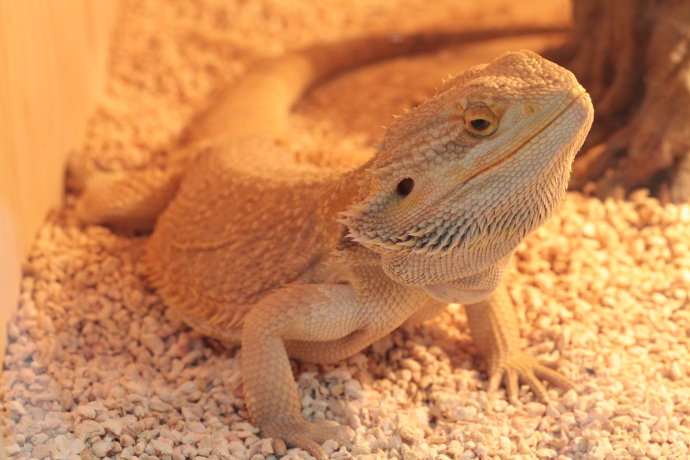(单词翻译:单击)
听力文本
This is Scientific American — 60-Second Science. I'm Jason Goldman.
Various animals evolved coloration that keeps them hidden. A jaguar's patterns help it slink undetected across the sun-dappled rainforest floor. The mottled pigmentation on the wings of some let them rest on tree bark undisturbed. And then there are animals that can quickly change their appearance—for example, the Central Bearded Dragon.
This two-foot-long lizard lives in the more arid parts of Australia.
"They can change color really quickly, just in a matter of seconds or minutes."
University of Melbourne biologist Katie Smith.
"And they do this by moving pigments within specialized skin cells called chromatophores."
Bearded dragons modify their colors for camouflage, or to maintain their body temperature, or to communicate with other dragons. Smith wanted to know how they meet all those needs with the same tool kit.
So she and her team rounded up twelve bearded dragons and put them through a series of tests before releasing them back into the wild. They found that when the dragons want to communicate with other members of their species, they change the colors on their neck.
"This is actually one of the reasons they're called bearded dragons—because they look like they have a really serious five o'clock shadow."

Changes to their backs were for temperature regulation. Shifting to yellow lets them to cool off during extreme heat, while darker greys allow them to soak up more heat during cooler weather.
"They actually save about, on average, 22 minutes a day at the darker colors than the lighter colors. That's about 85 hours throughout the whole year."
Eighty-five hours a year NOT spent out in the open and exposed to potential predators. The results were published in the Proceedings of the Royal Society: B.
The lizards can clearly control each part of their body separately, resulting in an efficient system. Temperature regulation involves the back, which is facing the sun. Social signaling uses the neck, easily visible to another lizard they're faced off with.
The researchers' next task is to see what happens when the lizards have to deal with simultaneous but conflicting coloration requirements—situations that could give a bearded dragon a close shave.
Thanks for listening for Scientific American — 60-Second Science Science. I'm Jason Goldman.
参考译文
这里是科学美国人——60秒科学。我是杰森·古德曼。
很多动物会进化颜色让自己隐藏起来。美洲豹身上的斑纹让它可以在阳光斑驳的雨林地带潜行。一些动物翅膀上的斑驳沉着色素可以让它们在树上休息时不被打扰。另外,还有些动物可以快速改变它们的外表,比如鬃狮蜥。
这种两英尺长的蜥蜴生活在澳大利亚的干旱地区。
“它们可以非常快速地改变颜色,仅仅只需要几秒钟或者几分钟的时间。”
凯蒂·史密斯是墨尔本大学的生物学家。
“它们通过转移特定皮肤内细胞内的色素来实现的。”
鬃狮蜥通过改变自己的颜色进行伪装、保持体温,或和其他鬃狮蜥进行交流。史密斯想知道拥有同样保护伪装的鬃狮蜥是如何满足这些需求的。
所以,她和自己的团队找了十二只鬃狮蜥,对它们进行了一系列的测试,然后再把它们放回野外。他们发现,当鬃狮蜥想和本物种的其他成员进行交流时,它们会改变自己颈部的颜色。
“这实际上是它们被称为长鬃狮蜥的原因之一,因为它们看起来像长了胡须。”
鬃狮蜥改变背部的颜色是为了调节温度。变成黄色可以让它们在酷热的天气中凉爽下来,而变成深灰色可以让鬃狮蜥在寒冷的天气吸收更多的热量。
“实际上平均而言,它们每天呈现深颜色的时间要比浅颜色的时间少22分钟。那么一年也就长达85个小时。”
这也就意味着它们一年有85个小时的时间没有在户外,而且不会接触到可能的捕食者。这项研究结果发表在《皇家学会学报B》上。
鬃狮蜥可以明确地控制自身各个部分,从而形成一个有效的系统。在有阳光时,可以调节背部的颜色。社交的时候调节颈部的颜色,让另一只鬃狮蜥清楚地看到它们面临的情况。
研究人员的下一个任务是观察鬃狮蜥在处理同时发生又相相互冲突的变色要求时会有什么情况发生,那可能是让它们死里逃生的情况。
谢谢大家收听科学美国人——60秒科学。我是杰森·古德曼。
译文为可可英语翻译,未经授权请勿转载!
重点讲解
重点讲解:
1. round up 使聚拢;使聚集;
例句:He had sought work as a cowboy, rounding up cattle.
他找了一份放牛的差事,负责把牛赶到一起。
2. cool off (使)变凉;(使)凉快下来;
例句:Maybe he's trying to cool off out there in the rain.
可能他是想在雨里凉快一下。
3. soak up 吸收;
例句:The cells will promptly start to soak up moisture.
细胞会立即开始吸收水分。
4. on average 平均起来;按平均值;
例句:On average, Mr. Kelly works out four days a week for at least an hour at a time.
凯利平均每周锻炼四天,每次至少锻炼一个小时。
5. result in 导致;引起;造成;
例句:His carelessness results in a serious blunder.
他的粗枝大叶导致他犯了一个严重错误。
6. a close shave 幸免于难;侥幸脱险;
例句:His life is no longer in danger, but it was a close shave.
他不再有生命危险了,但那真是死里逃生。


